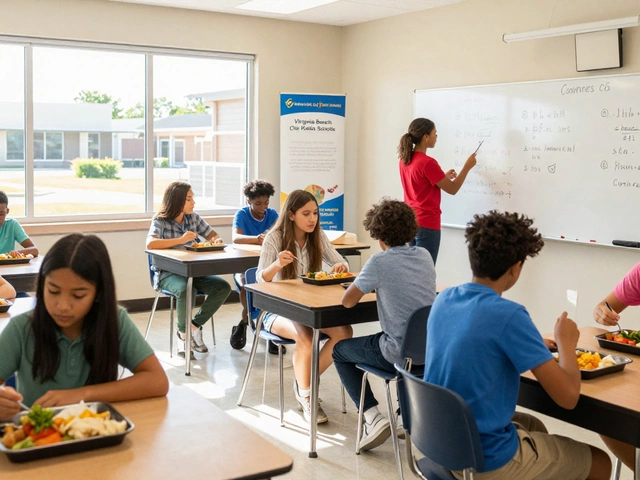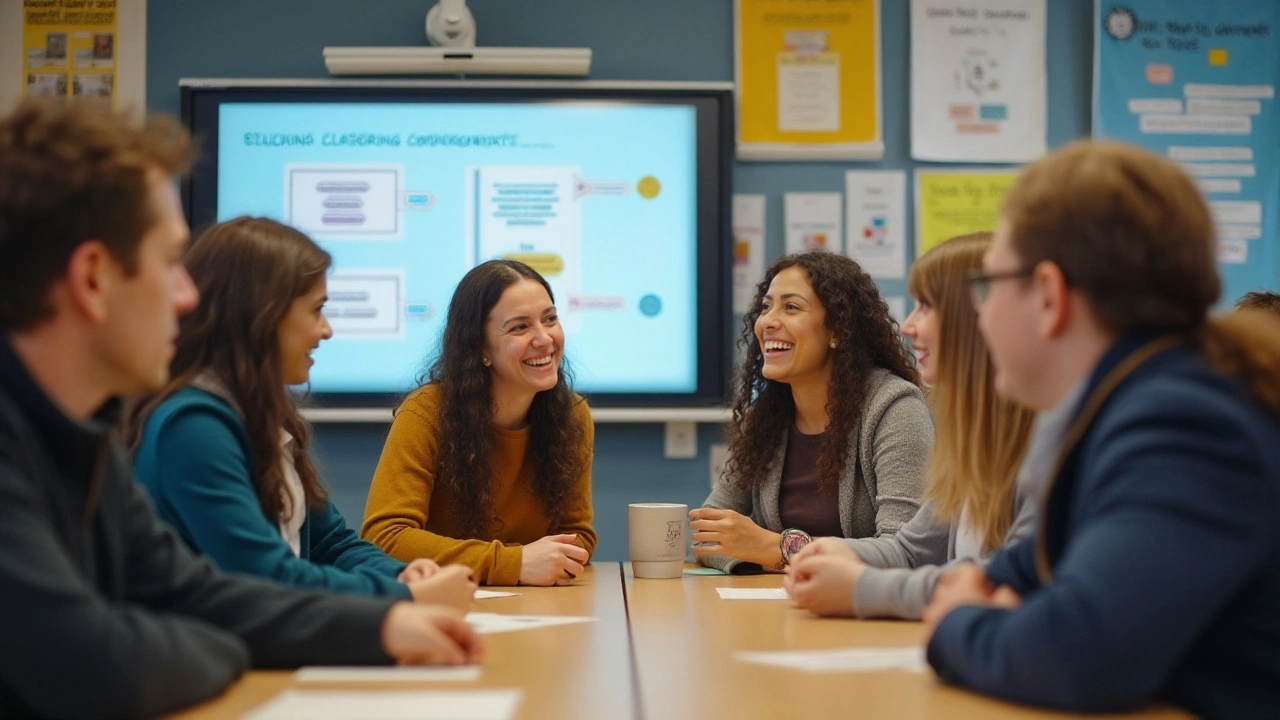Learning isn't just for the young. For adults, education can be a lifelong journey filled with opportunities and challenges. But why do adults learn differently? It boils down to three main contexts: institutional, situated, and self-directed learning.
Think of the institutional context as the formal setting — like schools, colleges, or specialized training centers — that provide structures for learning. On the other hand, the situated context is all about the environment and social interaction where learning naturally happens, whether it's in a workplace or a social setting. Lastly, self-directed learning gives adults the freedom to take charge of their own educational paths, picking what, when, and how they learn without much external influence.
Understanding these contexts not only aids in crafting better educational programs but also empowers adults to make the most of their learning experiences. Dive with me into an exploration of how these environments shape adult learning, offering insights that promise to make education more enriching for everyone involved.
- Introduction to Adult Learning Contexts
- Institutional Context
- Situated Learning Environment
- Self-Directed Learning
- Challenges in Adult Education
- Strategies for Effective Learning
Introduction to Adult Learning Contexts
Adult learning is a fascinating journey, unique for each individual but framed within certain common contexts that influence the learning experience profoundly. Unlike traditional childhood education, adult education must account for an array of factors, from previous knowledge and personal commitments to diverse motivations. It is crucial to understand the different contexts within which adults embark on learning — these are the institutional, situated, and self-directed environments. Recognizing and appreciating these contexts not only aids in optimizing educational frameworks but also helps in tailoring unique educational experiences that resonate with adult learners.
The first critical context is the institutional setting, which refers to formal education environments such as universities, community colleges, or professional training centers. These settings provide structured learning pathways that often come with a predefined curriculum, assessments, and accreditation. For many adults, returning to such institutions can mean balancing educational pursuits with the responsibilities of work and family. This competitive yet structured environment often fuels motivation through clear objectives and timelines, making the learning process rigorous but rewarding. The data suggests that adult students are the fastest growing demographic in higher education, underscoring the rising trend of adults seeking formal education to enhance skills or shift career paths.
Meanwhile, situated learning represents the learning that occurs naturally in the everyday environment. It emphasizes the social nature of learning, where knowledge and skills are acquired through observation and interaction within one's community or workplace. This context highlights the importance of social relationships and cultural practices, impactful elements that define how learning is absorbed and applied. Education theorist Jean Lave posits that in situated learning scenarios, "learners participate in a 'community of practice,' gaining practical insights from those in their surroundings." Understanding this context helps cut across artificial boundaries between academic knowledge and real-world application, making learning more relevant and cohesive for adults.
Lastly, there's the realm of self-directed learning, where adults become the architects of their own educational journey. This context thrives on innate curiosity, allowing learners to set their own goals, choose their resources, and dictate the pace of learning. This autonomy often leads to profound, personalized educational experiences as adults feel empowered and invested in the process. Self-directed learning also taps into informal resources such as online courses, workshops, or even books, providing flexibility that aligns well with the unpredictability of adult life. It is underscored by the work of education scholar Malcolm Knowles, who believed that adults are more self-directed and motivated than younger learners due to their need for autonomy.
In crafting programs and approaches that resonate with adult learners, understanding these contexts is pivotal. The nuances of how learning unfolds within each context not only paints a comprehensive picture of adult education but also points to tailored solutions that can elevate the learning experiences of adults around the globe. Whether it's through embracing institutional support, leveraging social landscapes, or championing self-motivated endeavors, these learning contexts provide the foundation for a thriving adult education landscape.
Institutional Context
When we talk about the institutional context of adult learning, we are referring to a structured environment where learning occurs in a formalized way. These settings typically include universities, colleges, community education programs, and vocational training centers. Here, education is not only planned but also standardized to meet certain benchmarks and goals. Learners attend classes, complete assignments, and are evaluated through exams or projects. This structured system can offer a clear pathway for achieving educational outcomes, which is particularly important for adults who may need certification or degrees to advance in their careers.
Traditional academic institutions have long recognized the unique needs of adult learners. Often juggling work, family, and studies, adults benefit from the flexibility that many universities now offer in the form of night classes, online courses, and weekend workshops. This flexibility is crucial for adults who are keen to embrace lifelong learning without sacrificing other commitments. In fact, a study by the National Center for Education Statistics found that nearly 60% of adult learners engage in part-time education, underscoring the demand for adaptable learning schedules.
Despite the rigid setting of the institutional context, there's room for innovation. Many institutions are investing in technologies that create dynamic learning environments and make education more accessible. The use of online platforms and digital resources is seen as a game-changer, enhancing the traditional classroom experience by providing a wealth of easily accessible information and interactive learning opportunities. A quote from the International Society for Technology in Education states, "Technology is a tool, not just for transforming static content but for empowering learners to be creators." This reflects the modern institutional belief that engaging adult learners requires adapting to new technologies and trends in education.
In these settings, adult learners often interact with peers and instructors, leading to a collaborative learning experience. The communication between instructors and learners in an institutional setting can have a huge impact on motivation and learning outcomes. Effective instructors in these environments recognize the wealth of experience adult learners bring and often use it as a foundation to build new knowledge and skills. This ability to relate educational content to real-world experiences can greatly enhance learning, making it more applicable and meaningful for mature students.
Nevertheless, challenges persist in the institutional learning context, particularly concerning affordability and access. Tuition costs can be prohibitive for many adults, especially those considering a complete career change that requires significant retraining. Institutions are increasingly exploring options like scholarships, financial aid, and employer partnerships to support adult learners financially, recognizing that these investments result in skilled and knowledgeable graduates who contribute positively to the workforce and society. Ultimately, the institutional context remains a cornerstone in the landscape of adult education, one that requires continuous adaptation to meet the evolving needs of its diverse student population.

Situated Learning Environment
The concept of a situated learning environment comes to life when we move beyond the walls of traditional classrooms. Here, learning is deeply connected to its context, filled with interactions that resonate with real-life scenarios. Imagine a workspace where employees learn by working through tasks, or a community gathering where skills are shared informally through collaboration. The idea centers around the notion that knowledge is concealed within the intricacies of the environment and experiences one engages with daily.
Learning in such settings isn't confined to theoretical concepts but rather emerges organically through the activities and priorities that define a particular context. For example, take the apprenticeship model, where learning occurs directly through practice and mastering specific skills in a real-world context. This learning style fosters deeper understanding as adults can immediately see the relevance and application of their new knowledge in tangible ways. One might argue that situated learning’s strongest suit is its ability to make education authentic by tying it to everyday life.
Research has shown that adult education in these environments often results in higher retention rates of knowledge. When learners can connect with their roles, whether personal or professional, the absorption of information is significantly enhanced. Consider an example from a study by Lave and Wenger, who explored how communities of practice contribute to lifelong learning. They suggested that learning occurs as individuals participate in communal activities, offering a blend of shared practices that support identity development and knowledge acquisition.
"Learning is an integral and inseparable aspect of social practice," noted Lave and Wenger, capturing the core essence of this learning model. Viewing it from this perspective helps us appreciate the profound influence social environments have on adult learners.
Some may wonder how effective strategies can be implemented to support such environments. It's about creating opportunities for collaborative learning, where interaction and dialogue fuel discovery and understanding. Imagine remote teams using technology to simulate situational learning, leveraging digital tools to create virtual environments that mirror real-world conditions. This adaptability highlights the potential of situation-based learning to transcend barriers and cater to diverse learning needs.
Practical Steps in Situated Learning
- Engagement in real-life tasks relevant to the learner's context.
- Collaboration with a community or group to foster shared learning experiences.
- Utilizing technology to simulate authentic environments where traditional settings are not feasible.
- Continuous reflection on personal experiences to reinforce learning.
- Mentoring and peer support networks are essential components for promoting practical understanding.
Incorporating these steps effectively can transform how adults engage with learning, coupling knowledge with real-world application. As we delve deeper into the dynamics of adult learning, it's clear that situated environments hold a unique position. They blur the line between learning and doing, transforming education into a seamless part of life’s daily hustle and bustle, which could explain why they're so powerful. For anyone keen on designing impactful educational journeys, understanding and utilizing these social contexts can unlock new possibilities and enrich every learner's experience.
Self-Directed Learning
Self-directed learning is a dynamic process where adult learners take the reins of their own educational journey. Unlike traditional learning methods, where structured curricula and schedules dictate the pace and content, self-directed learners choose what they want to learn, how they want to master it, and when they will engage with the material. This autonomy empowers them to pursue topics that satisfy their curiosity or directly relate to their personal or professional goals. Such freedom, while liberating, also requires a high level of motivation and discipline, often unseen in formal educational settings.
Historically, the concept of self-directed learning finds its roots in the educational philosophy of thinkers like Malcolm Knowles, who defined it as the process where individuals take the initiative, with or without help, in diagnosing their learning needs, formulating goals, identifying resources, and evaluating outcomes. A fascinating element of self-directed learning is how it aligns with adult learners' life experiences. Since adults bring a wealth of knowledge from their past careers and life events, they can often connect new knowledge to these experiences, deepening their understanding and retention of the material.
The transition to self-directed learning can be both thrilling and daunting. For many adult learners, it represents a significant shift from past educational experiences, where rote learning and passive absorption of knowledge ruled. As they embark on this journey, learners might face challenges such as time management, selecting credible resources from the vast ocean of incorrect information, and maintaining motivation without external pressures. However, the rewards can be substantial: a deeply personalized education journey, skill acquisition that directly impacts one's career, and an invigorated sense of curiosity and personal satisfaction. As Edgar Faure once stated in 'Learning to Be', "In a world of fierce competition and rapid change, individuals who are self-directed can adapt and thrive in diverse environments."
According to a survey conducted by the Pew Research Center, a notable 73% of American adults consider themselves lifelong learners, with self-improvement and work-related skills topping the list of their pursuits. These statistics underscore the rising importance of self-directed learning in today's evolving educational landscape. Educational platforms and technology have flourished to support this drive, offering online courses, webinars, and virtual forums to facilitate shared learning experiences while accommodating diverse learning styles and schedules. By embracing these advancements, adult education becomes not just a ticking of boxes but a voyage filled with passion and purpose.

Challenges in Adult Education
Adult education, while rewarding, comes with its own set of hurdles. Unlike children or teenagers, adults step into the educational arena often tasked with juggling other responsibilities. Balancing work, family, and maintaining a social life requires sophisticated time-management skills and can become a daunting barrier. It's no surprise then that many adult learners struggle with finding the time and energy to dedicate to their educational pursuits. Additionally, the availability of flexible learning options is critical, yet not always present, which can complicate the pursuit of knowledge for those with irregular schedules.
Financial constraints often play a significant role as well. While some educational programs offer financial aid or scholarships, many adults have already accumulated costs related to their personal lives, such as mortgages, healthcare, and childcare. Consequently, the decision to dive back into learning may come with hefty financial considerations. This issue can deter potential learners from engaging in adult education, despite the potential long-term benefits. A report by the Lumina Foundation indicates that adults with some college experience but no degree often cite work and expenses as major hindrances to completing their education.
Cultural and psychological barriers add another layer of challenge. Many adults harbor anxiety about returning to a learning environment, especially if it involves unfamiliar digital platforms or technology. This anxiety can be exacerbated by past educational experiences or a belief that they might not be able to keep up with younger students. Furthermore, social expectations often impose pressure; adults might feel burdened by the idea that education should have been completed earlier in life. Institutions that understand these nuances can provide tailored support to help bridge these psychological gaps.
"Adult learners bring a wealth of experience with them, but they also carry anxieties about competence and adapting to new educational environments," notes Dr. Robert Nash, a seasoned educator in adult learning.
In addition, technology can both aid and confound. The rising prevalence of online courses offers unprecedented access to information. However, not all adults are equally tech-savvy. Navigating online learning platforms and digital resources can be prohibitive for some, acting as a barrier rather than a bridge to learning. Educational institutions aiming to cater to this demographic must consider intuitive design and comprehensive tech support to assist learners in easily accessing course materials and participating actively in classes.
Lastly, motivation can fluctuate, with some adults starting their educational journey with enthusiasm only to find it waning in the face of real-world demands. Establishing clear goals and receiving regular feedback can significantly bolster student engagement and perseverance. Interactive tools and community learning sessions can also add an element of encouragement, reminding adult learners that they are not alone in their educational quests.
All these challenges highlight the need for flexible and responsive educational systems that acknowledge the unique needs of adult learners. Innovative strategies, grounded in empathy and practicality, can minimize these hurdles, ensuring that a broader range of individuals can access and benefit from lifelong learning opportunities. As education continues to evolve, addressing these challenges becomes essential to making adult learning both a feasible and an appealing choice.
Strategies for Effective Learning
When it comes to achieving success in adult learning, employing effective strategies can make a substantial difference. As adults often balance multiple responsibilities—from work commitments to family duties—it's vital to embrace strategies that respect their unique learning contexts. One proven approach is the incorporation of practical, real-world applications into learning materials. This not only makes the knowledge more relatable but also reinforces the applicability of concepts. Coupled with this is the significance of setting clear, achievable goals. Clear goals provide direction and motivation, serving as benchmarks to measure progress and celebrate achievements along the journey.
For adult learners thriving in an institutional context, the integration of technology can enhance learning experiences significantly. Online learning platforms and digital resources can make education more accessible and flexible, aligning with the demands of adult life. Leveraging tools like simulations and interactive modules can also boost engagement and retention. Research indicates that adults learn better when they actively participate in the learning process, which is why interactive methods can be beneficial. Considering the diversity among adult learners, personalized learning plans, which adapt to individual needs and preferences, are essential to accommodate different learning speeds and styles.
A quote by Malcolm Knowles, an American educator famous for the adoption of the theory of adult learning, andragogy, reflects this well: "Adults are most interested in learning subjects that have immediate relevance to their job or personal life."
In the realm of self-directed learning, fostering intrinsic motivation is key. Encouraging learners to choose subjects or skills they are genuinely interested in enhances commitment and engagement. To aid this process, providing diverse resources, from books and articles to podcasts and webinars, caters to various learning styles and preferences. Additionally, establishing a supportive community, whether online or in-person, allows learners to share insights, ask questions, and gain different perspectives. This community support can be a crucial factor in maintaining learner motivation and support.
Additionally, leveraging lifelong learning strategies involves being open to feedback and reflection. Regular self-assessment can help learners identify areas of improvement and adjust their strategies accordingly. It's also important to embrace mistakes as learning opportunities rather than setbacks. Encouraging reflection after each learning episode helps in consolidating knowledge and identifying practical applications. Furthermore, engaging in metacognitive strategies, where learners are aware of their own learning processes, aids in better self-regulation and adaptability over time.






